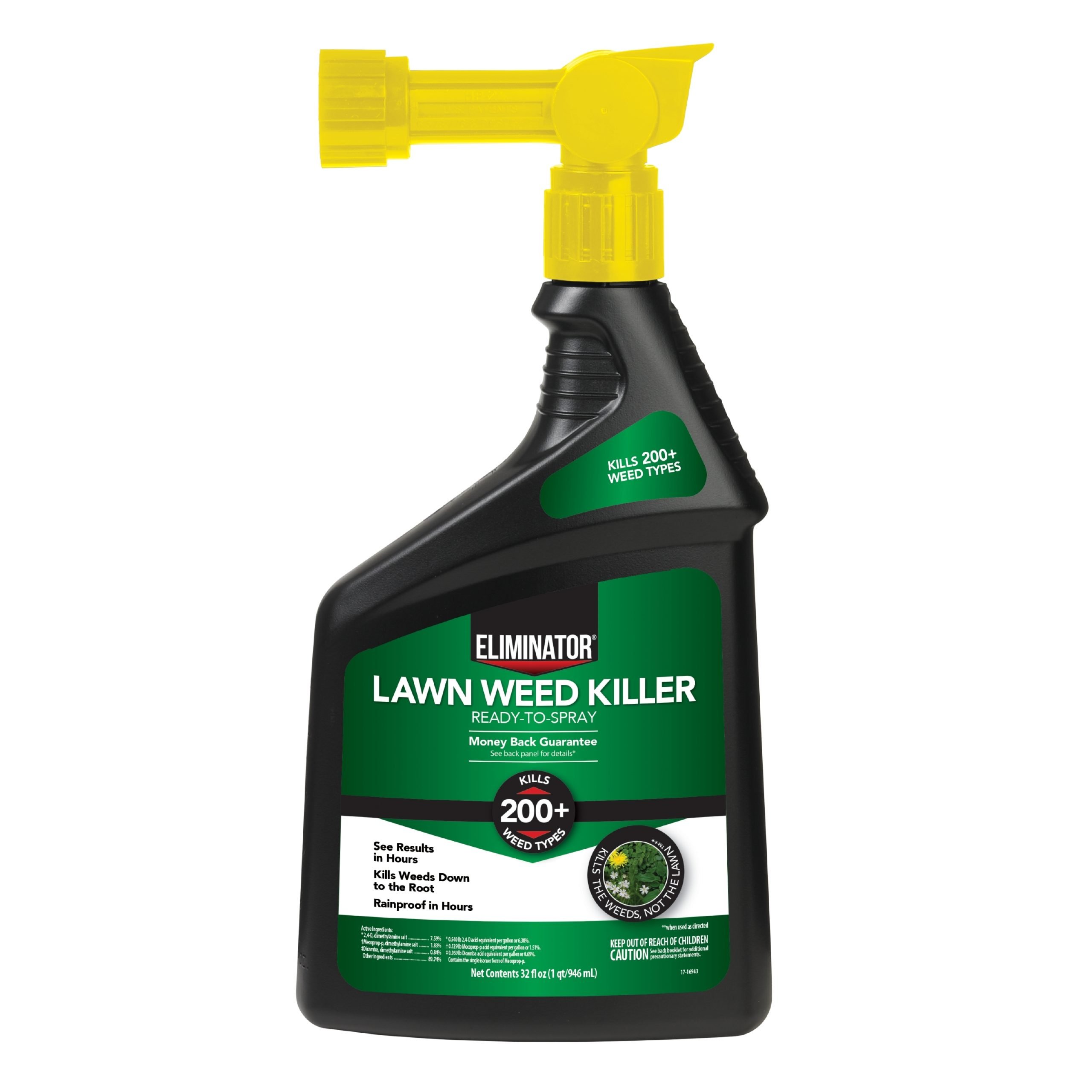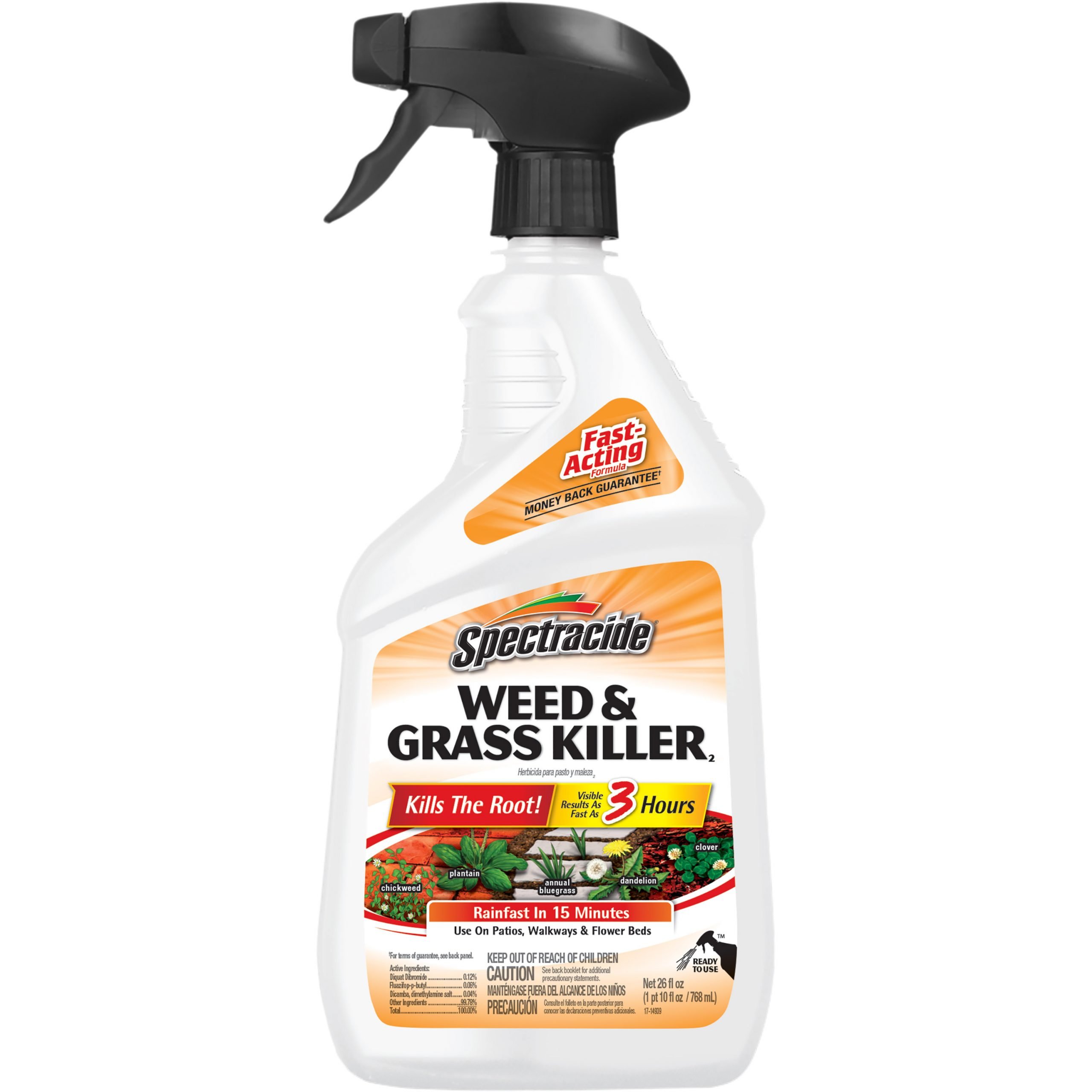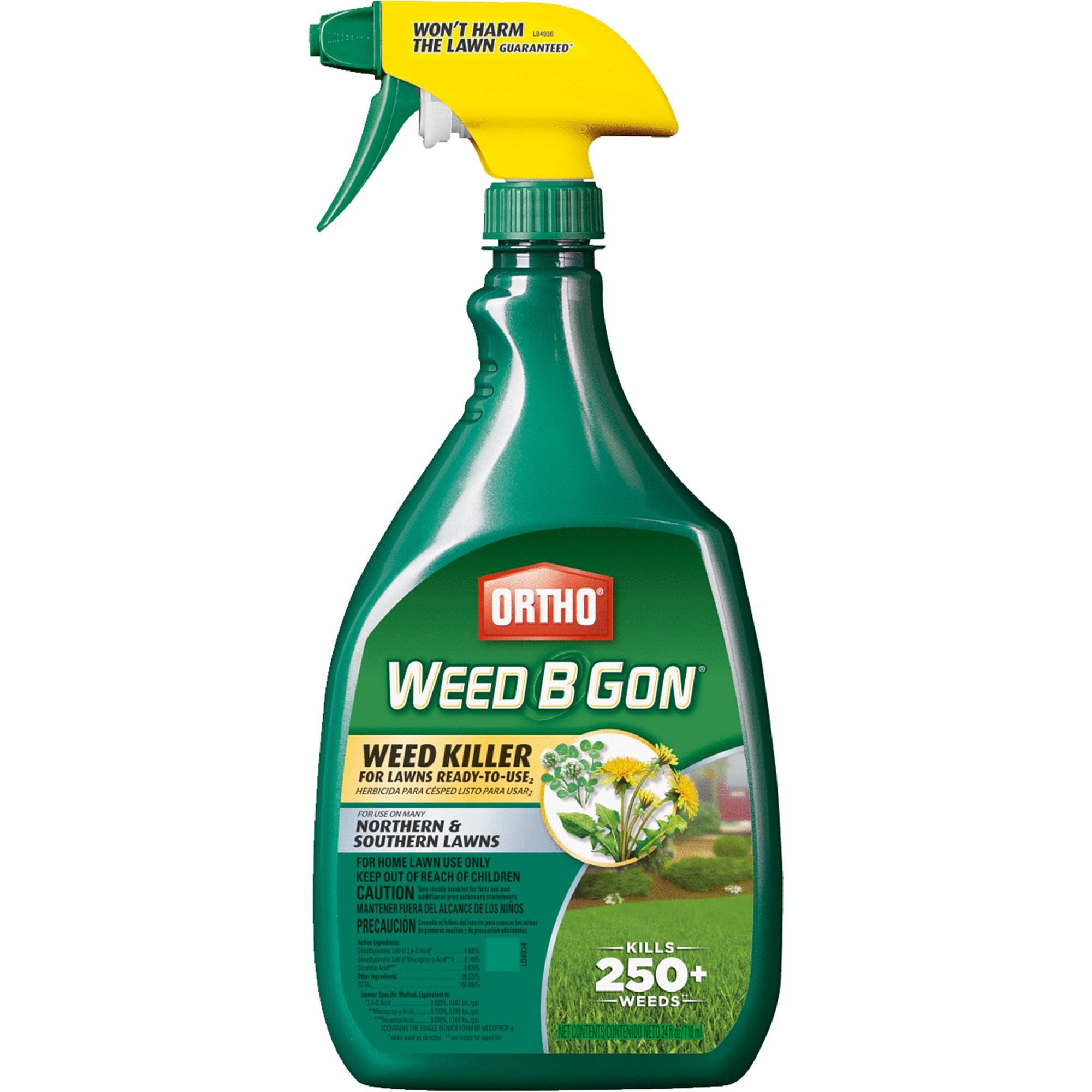Scotts 32367f Turf Builder Halts Crabgrass Preventer
Early Weed Prevention for Your Lawn
Scotts Turf Builder is a pre-emergent weed killer and fertilizer in one. It’s best applied in early spring and fall. Similar to other weed preventers, this product is specifically designed to prevent crabgrass seeds from germinating, but it also prevents weeds like foxtail, barnyard grass, oxalis, and chickweed. At the same time, it feeds your lawn to promote strong, healthy growth. This has the added benefit of crowding out any weeds that might want to grow. Plus, you can use it on St Augustine grass.
Treating your lawn just before the growing season is one of the best things you can do. This product will not only prevent weed seeds from germinating but will also fertilize your growing lawn. Plus, a lush, thick lawn discourages weeds from taking hold during the growing season.
FormCoverage AreaOrganic
Roundup Weed And Grass Killer
Amazed at how your lawn weeds keep on coming back after spraying them with your weed killer? Surely, your weeds are not plants from hell just because they dont seem to die. In fact, your weed killer spray might be the one to blame. If your typical weed killer spray is anything but talk and no action, its time you switch to Roundup 5725070 Extended Control Weed and Grass Killer Plus Weed Preventer.
The thing is, moist areas provide a suitable breeding ground for weeds. To prevent them from growing, you need to remove them before they have tubers and spray them with Round 5725070 Extended Control Weed and Grass Killer Plus Weed Preventer. This Weed Killer Spray contains an important ingredient that kills weeds to the root. Actually, it has components that instantly zap away both new and current weeds for four months.
This 15.8-pound product measures 13 inches long, 10 inches wide, and 7 inches thick. It has a ready-to-use pump n go sprayer that you can easily put on driveways, sidewalks, patios, fences, foundations, curbs, lawn edges, and gravel areas. Furthermore, its rainproof for 10 minutes and you can see visible results within three hours.
Master The Application Basics
Its always ideal to catch weeds in the early growth stages. Check the bottle to find even more info on the best way to treat each specific weed and comprehensive step-by-step instructions.
Point the nozzle away from your body, and keep your finger on the trigger for continuous spray.
After using a Roundup® For Lawns Product, find a good place to keep it. You know, one where it wont freeze or overheat.
It takes about 2-3 days for weeds stems to start twisting, so check back in a few days to see the results.
Read Also: Aerify Plus Lowes
Applying Granulated Weed Killers
Herbicides that are granulated can be pre-emergent products that are applied to lawns twice a year to prevent weeds from growing. These types of weed killers can be for industrial use on farms and fields or residential lawns. Youll need an extra device called a spreader to apply a granulated weed killer evenly to your lawn.
A spreader is a device that resembles a wheelbarrow. The weed killer granulates are poured into the top of the device and as you move it around your yard it sprinkles the herbicide over your lawn. In order for this type of weed killer to work, you must mow your lawn first before applying the herbicide. After youve applied the weed killer to your lawn you must water your garden lightly so that the herbicide can mix with the liquid and seep into the soil.
The best time to apply these types of herbicides is in the late afternoon when the sun starts to go down. This ensures that the water doesnt evaporate. These types of herbicides are applied at the beginning of spring and fall. Check whether this weed killer is suitable for St Augustine or other sensitive lawns so that it doesnt destroy your grass.
Best Commercial Weed Killer

Its well known that the best solution is the organic cultivation of plants, especially vegetables and fruit bushes. Therefore, moulting weeds would be the best solution. But this involves doing extremely hard, repetitive, and tiring work. Many species of weeds grow back from the root. Removing them permanently from the ground is not possible. It also requires regularity. For people who have a large garden, its really difficult. Choosing the best commercial weed killer is therefore absolutely essential.
For this reason, its worth using herbicides which have an effect on the whole plant. They remove not only the aboveground but also the underground part. Using the best weed killer concentrate will contribute to speeding up the process. In 2020, the top rated organic weed killer is offered by Sierra Natural Science in ready to mix pouches.
Also Check: How To Get Rid Of Wild Violets In Flower Beds
Best Time To Spray Weeds: Before And After
One of the best times to spray weeds is before the weeds appear. Its called pre-emergent, and its a crucial part of weed control. Pre-emergent weed control is designed to target the weed seeds before they sprout.Crabgrass is a great example of the need for pre-emergent.Its crucial to apply crabgrass pre-emergent in early spring to target those weed seeds as they germinate and take root in the soil so they dont become more seed-producing plants.But weeds are sneaky and tough, and some sneak through despite your best efforts.Enter post-emergent products. They kill weeds once they already exist in their dastardly leafy form.
Features To Consider When Buying Weed Killer For Lawns
As mentioned before there are a few features you must look at before you purchase your herbicide. Its highly important that you consider these features mentioned in this next section because some herbicides arent suitable to use on sensitive lawns such as St Augustine grass.
In these features we will discuss suitable brands to utilize for the species of weeds you have and if its a product thats ready to use or a solution that requires mixing.
Also Check: Lowes Hydroseed
Can I Spray 2 4
If you want to kill broadleaf weeds, youre probably wondering if you can spray a 2, 4-D on your lawn. Yes, it is safe to apply 2, 4-D on your lawn, but it is important to get the mixing ratio, timing, and application rate right.
2,4-Dichlorophenoxyacetic acid is a systemic herbicide that selectively kills broadleaf weeds. It destroys weeds by altering the way the cells of these plants grow, thereby killing them. In other words, it causes uncontrolled growth of cells in broadleaf weeds, thereby eliminating them.
2, 4-D is classified as an auxin-type herbicide because it causes cells in plant tissues that transport water and nutrients to grow endlessly.
Weed Identification And Herbicide Selection
After these cultural problems have been addressed, the weeds of concern must be accurately identified so that the appropriate herbicide may be selected. Proper weed identification is very important because understanding the weeds life cycle is the key to weed management. Herbicides vary in their effectiveness in controlling specific weeds, and some may not provide any control against the targeted weed. Choosing the wrong herbicide due to a misidentified weed can easily result in large amounts of money spent with no control of the weed. Common Weeds and Wildflowers is a complete, up-to-date weed identification guide available from the Cooperative Extension Service. The local Cooperative Extension agent or the Home & Garden Information Center can also help with weed identification, and determine which herbicide will be most effective based on research data and herbicide label information. They can also point out possible concerns when using a specific herbicide. These may include wind drift to nearby plants, volatilization problems, spray water pH and water quality issues, potentially harmful application over root systems of nearby woody plants, and requirements to apply the herbicide during a specific growth stage of the turfgrass or the weed to be controlled.
Also Check: Kill Wild Violets In Grass
Why Does The Time Of Year Affect Weed Killers
Spring is the best time of year for applying weed killer. This is because you can catch weeds in their pre-growth state, before theyve had the opportunity to sprout fully. Spring has the advantages of being both warm and wet.
Herbicides in weed killers require absorption from the soil to activate. This absorption can only take place if the soil is moist from the rain. Spring being a typically rainy season ensures that the soil is wet enough to soak up the herbicide, which is then taken up by the plant root.
Without any rain, the herbicide solution will sit on the soil, rather than being absorbed by the plant.
Fall is the second-best season because weed killers thrive on the sudden change in weather. Spraying weed killer in October means that weeds will struggle to survive the winter.
However, not all weed killers contain herbicide, and can therefore be used at all times of year. For example, Foamstream is a herbicide-free weed killer. This means its not affected by the levels of moisture in the soil.
When To Use The Spray Weed Killer
The vast majority of available weed killers are absorbed by the weed leaves just after spraying, and then reach the rest of the plant. This destroys the whole weed along with its roots. In order for the preparation to be absorbed, the weeds must have formed enough leaves.
It is best to spray when the weeds have clearly formed 3-4 leaves each. It is also necessary to keep an adequate distance between spraying and mowing the grass. Never spray on the weeds just after mowing the lawn because the weed leaves are also mowed and the weed killer will not be absorbed. Dont mow immediately after spraying. Wait until the product is fully absorbed.
Read Also: Rgs Biostimulant
Best Conditions For Using Weed Killer On Your Lawn
Besides understanding whether spraying weeds before or after mowing is the right thing to do, there are various other conditions that you must consider to ensure more effective weed control. Some of these are:
- Use the killer when there is enough moisture in the soil. Doing so in drought conditions can harm your lawn.
- Apply the weed killer on dry grass and when it is less likely to rain for at least six hours. However, granular killers need to be applied when the grass is damp to ensure that they stick on the leaves long enough to be absorbed by the weeds.
- During the summer season, it is best to apply the weed killer in the evening when the sun is less strong.
For the best results, use weed killer only before mowing your lawn. You shouldnt mow immediately after applying weed killer either. Instead, let it rest for about a week for the chemicals to be absorbed by the unwanted plants.
Related
What Is The Proper Way To Apply A Broadleaf Herbicide To The Lawn

Broadleaf herbicides can be applied as liquids or granules. Before applying any herbicide, carefully read and follow label directions.
When applying liquid formulations, avoid potential spray drift problems by following simple precautions. Dont spray when winds exceed 5 mph. Also, dont spray when temperatures are forecast to exceed 85 degrees Fahrenheit within 24 hours of the application. Since coarse droplets are less likely to drift than fine sprays, select a nozzle that produces coarse droplets and use low sprayer pressure when applying liquid broadleaf herbicides.
When spraying, keep the nozzle close to the ground. If only a few areas in the lawn have broadleaf weeds, spot treat these areas rather than spraying the entire lawn. Apply just enough material to wet the leaf surfaces. A single application of a broadleaf herbicide kills many broadleaf weeds. Difficult-to-control weeds, such as violets, will likely require two applications.
Granular broadleaf herbicides are usually combined with fertilizers. Apply granular broadleaf herbicides and fertilizer/broadleaf herbicide combinations when the foliage is wet. Broadleaf herbicides are absorbed by the weeds foliage, not its roots. To be effective, the granules must stick to the weeds and the herbicide absorbed by the weeds foliage. Apply granular products in the early morning when the foliage is wet with dew or irrigate the lawn prior to the application.
Read Also: How To Make Lines In Your Lawn
Follow The Instructions To Treat Weeds
Not all weed treatments are created equal. Make sure that you thoroughly read and understand the instructions that your weed killer comes with. Some chemicals could prove to be hazardous to your lawn or your pets. Some killers can be used multiple times on the same patch of land with no negative side-effects, while others are strictly one-use only.
Whole Lawn Or Spot Treatment
- If the weeds are sparse or limited to certain areas of the lawn it is not necessary to spray the whole lawn you can spot spray the weeds or only spray the affected areas.
- Coarse grasses can also be a weed in fine turf lawns. The broadleaf weed killers will have little effect on these and spot treatment with Weed Weapon Invade Gel is the best option. Apply the gel to the central growing crowns of the coarse grass.
Also Check: Keep Rabbits Off Lawn
Do You Have To Pull Weeds After Spraying
Only pull the weeds when they are completely dead. If you leave dead weeds in your garden, the dead plants can accumulate and cause new unwanted plants to grow from residual seeds. Its always best practice to remove weeds from your garden altogether, even if youve already sprayed them with herbicide.
When To Apply Pre
Early Spring and Fall are the most effective times to apply pre-emergent herbicides. They can be applied throughout the year, and will still prevent new weeds that sprout, however most weeds sprout during spring and fall. Spring applications target different weed species than Fall applications, so it is very important to know the type of weed you are trying to prevent for best results. See below for help identifying your target weeds.
Recommended Reading: How To Change Oil In A Riding Lawn Mower
What Is The Best Time Of Year To Use Weed Killer
If youre applying weed killer but arent seeing results, youre not alone.
Applying weed killers that contain herbicides isnt as easy as it initially seems, and many people struggle with commercial weed control for this very reason.
Unfortunately, with most herbicide-based weed killers, the effectiveness will be affected by external factors. This includes the weather conditions at certain times of year, the specific weed you are trying to eliminate, and the life cycle of that weed.
As youre trying different tactics with your weed killer, you may find yourself asking what is the best time of year to use weed killer?. Thats what Weedingtech is here to help you with.
How Long Does It Take For Weeds To Die
Weeds are more quickly controlled when growing conditions are great. If the weather gets really hot, very cold, or extremely dry, weed control results will be slowed down more than typical.
Generally speaking, we tell customers that if they dont see weeds starting to yellow and die within 2 weeks to give us a call so that we can come back and make sure theyre taken care of. We think its important to stay on top of weed control for our clients as we know how much they value this service so we always ask to be kept in the loop if they feel something isnt right.
Transforming a weedy lawn can take a good amount of time, specifically if the grass is thin and if you have some tougher varieties of weeds. We often tell new clients that although youll see great progress along the way, it can take 3-4 visits until there are drastic changes and to be patient. A year down the line, youll forget how your thick, lush lawn ever looked that bad!
You May Like: How To Get Rid Of Clover In Lawn Without Chemicals
Tips To Avoid Common Mistakes
Gardeners and planters should have knowledge about weed propagation. Ignorance of these things can even contribute to their increased spread. Weeds that propagate from seeds bloom in summer and sow an enormous amount of seeds. Pulling or cutting them out during the flowering period stimulates their growth. It contributes to even more abundant sowing. To avoid this problem:
Tips For When And How To Apply Weed Killer To Your Lawn

When planning to apply weed killer plan around a predicted rainfall or sprinkler application, and severe hot days or mowing schedule.Weed killers are a contact killer, meaning they absorb the chemical through what comes in contact with the leaf surface and then translocates the chemical throughout the plant. Since weed killers are dependent on contact, it is very important to get good contact with the weed.
Granular weed killers should be applied when grass is damp and should not be watered for 48 hours after application. The dampness of the grass ensures the granular weed killer will “stick” to the leaf. Water applied too soon after application can wash off the weed killer from the surface of the weed before it can be absorbed.
To get good contact with the weed, don’t mow the grass before applying weed killers. Mowing eliminates the weed’s surface area and ultimately decreases the success of the weed killer. Plan to leave your grass uncut for two days after application and five days before.
During drought conditions or if you are having trouble getting adequate control, add spreader sticker which will increase absorption of the weed killer. During stress periods, plants tend to be more defensive and the addition of spreader sticker can be beneficial.
Applying weed killer is a five-step process:
Don’t Miss: Lawn Mowing Estimates
